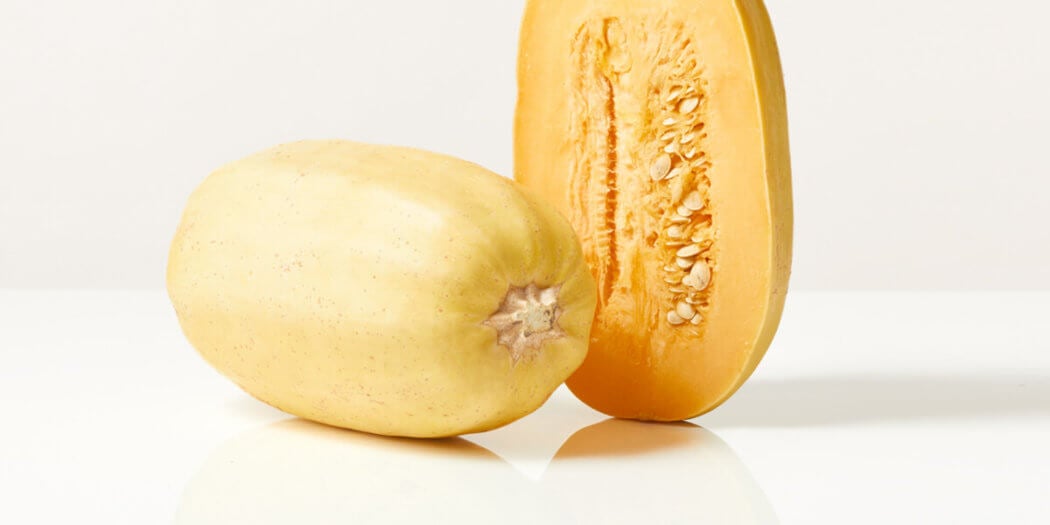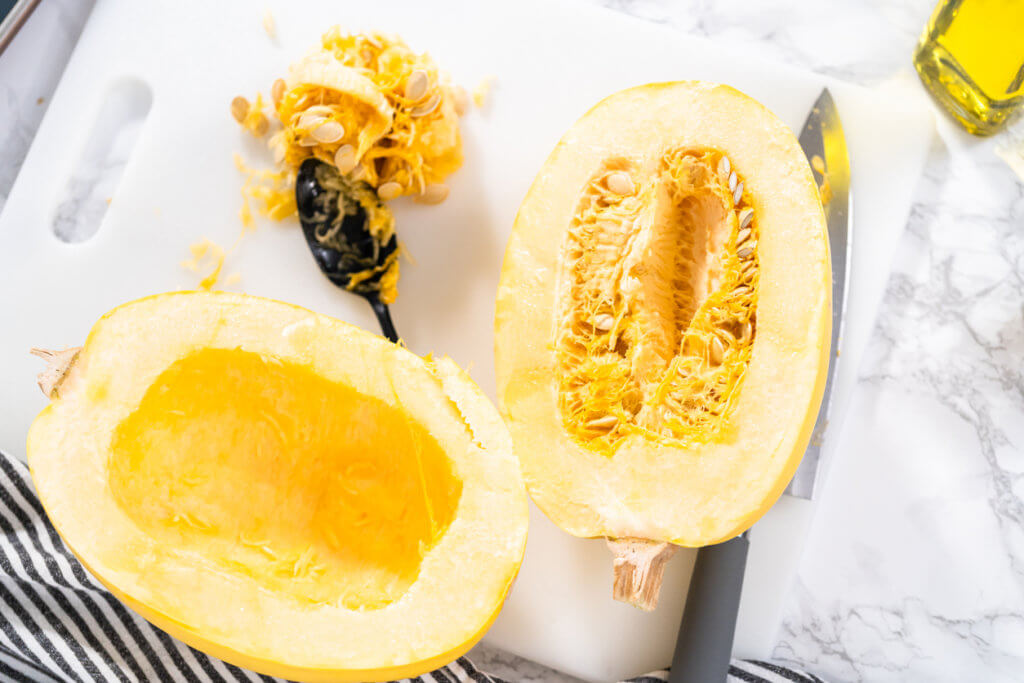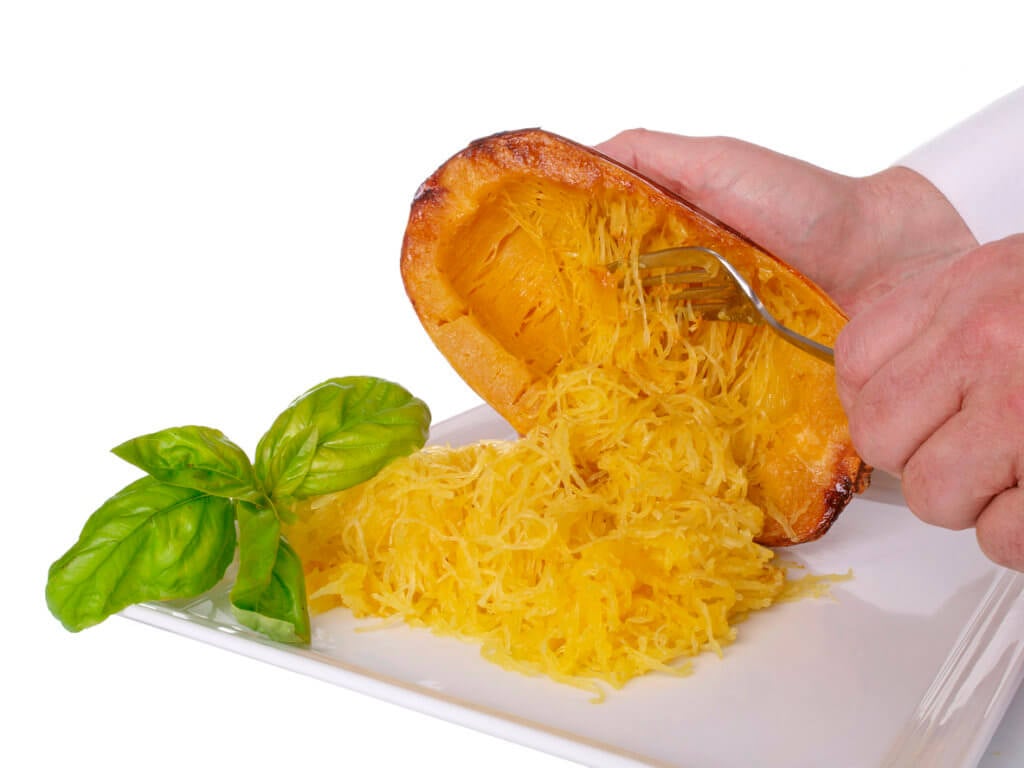Recipes
How to Cut Spaghetti Squash with Step-by-Step Instructions

A gourd like no other, the flesh of the spaghetti squash easily tears apart into thin and tender strands when cooked. Spaghetti squash grows in various sizes and colors, such as yellow, orange, and white. When cooked well, shredded spaghetti squash can be used as a low-carb substitute for pasta.
How to cut a spaghetti squash
Before cooking your spaghetti squash, you will need to cut it correctly. Spaghetti squash has a thick and hard outer skin, so you will need to proceed carefully with a sharp knife. There is a particular way you should cut your spaghetti squash before you cook it.
1. Preparing to cut
Before you begin cutting, you’ll want to gather a few supplies: a sharp chef’s knife, a cutting board, a spoon, and a small bowl.
After cutting your spaghetti squash in half, you will use the spoon to scoop out the seeds into the small bowl. Make sure your chef’s knife is nice and sharp before starting to cut. Do not attempt to use a serrated knife to cut spaghetti squash, as you will want to slice the squash in half with one clean downward stroke.
Place a towel or kitchen rag underneath your cutting board if you need to keep it from sliding around. You won’t want it to move accidentally while cutting your spaghetti squash.
2. Cutting the squash

With everything in place, you are ready to cut the spaghetti squash. You will be cutting the spaghetti squash longways, from base to stem. Here is the easiest way to cut perfectly down the middle every time:
- Lay the spaghetti squash longways across on your cutting board.
- Slice off the top part of the spaghetti squash, about 1-2in below the stem, leaving behind a smooth flat surface.
- Rotate the spaghetti squash and cut off the bottom 1-2in, again leaving behind a smooth flat surface. Discard both the base and the stem pieces.
- Stand the spaghetti squash up vertically, with the broadest end resting on the cutting board.
- Position your knife at the top of the spaghetti squash, positioning the blade edge right in the middle.
- Slowly push the blade down into the top of the spaghetti squash, just a few inches until the spine of the knife starts to disappear.
- Gently place your palm on the top of the spaghetti squash to hold it as you slice the knife all the way down to complete the cut.
- Separate the two halves and scoop out the seeds.
Now you have two perfectly cut spaghetti squash halves that are ready to cook!
What do you do with spaghetti squash seeds?
Before you start cooking, take a quick moment to deal with the seeds. Of course, you can discard them, preferably by dropping them in a compost bin. You could also save some to try growing your own spaghetti squash in the future.
Or, you can rinse them off, pat them dry, toss with oil, and bake them just like pumpkin seeds. Spaghetti squash seeds may be slightly smaller, so they will roast a bit faster than pumpkin seeds.
Cooking spaghetti squash
With your two perfectly cut spaghetti squash halves, you are ready to start cooking. If you’re not, wrap your spaghetti squash halves tightly in plastic saran wrap and put them in the refrigerator for no more than a day or two. When you are ready to cook, there are two typical methods for cooking spaghetti squash: in the oven or the microwave.
1. Baked in the oven
Many prefer the roasting in the oven method, as it produces more flavor from caramelization. To prepare spaghetti squash to cook in the oven:
- Rub the inside of both cut halves with olive oil. Be sure to cover the entire surface area completely, except for the outer skin.
- Sprinkle to taste with salt and black pepper.
- Use a fork to poke several holes into the flesh of the spaghetti squash. This will help it cook more evenly.
- Place the cut sides down on a baking sheet and bake in a 400°F oven for 30-40 minutes.
When you remove the spaghetti squash from the oven, flip the halves over so that they are skin-side down. Use the fork to test them to see if they are done. You’ll know they’re done if the flesh is easily scraped apart by your fork. If your spaghetti squash needs more time, flip them back over and roast a few more minutes in the oven. When it is done, set your spaghetti squash to the side to cool off.
Pro tip: The squash will be extremely hot! Do not handle with your bare hands until it has had a chance to cool off for a bit. Use an oven mitt or utensil to carefully transfer the squash from the baking sheet to a plate or bowl where it will cool off faster.
2. Cooked in the microwave
If that sounds like a lot to you, cooking spaghetti squash in the microwave provides a quicker and easier method.
Just place the cut side down of the spaghetti squash into a microwave-safe baking dish, remembering to poke some holes in the flesh with a fork first. Add about 1in of water. Don’t add too much, as it will make your squash too watery. Microwave for about 10 minutes, and add more time if needed.
3. How to soften spaghetti squash in the microwave
Some recipes call for microwaving the squash whole first, before cutting it in half, for about 5 minutes. Doing this will soften the squash a bit, making it easier to cut in half. If you do this, remember to poke holes with a fork or knife before microwaving.
How do you scrape the insides of spaghetti squash?

Once your cooked spaghetti squash has cooled off for at least 10-15 minutes, you are almost ready for the fun part—scraping the insides!
Carefully hold the skin of the squash and use a fork to scrape the insides in an up and down motion. Scrape the squash longways to generate more noodle-like strands. Dump the scrapped insides into a bowl and discard the skin.
Now you are ready to eat your cooked spaghetti squash as a healthy snack or as part of a recipe. Serving with a marina or pesto sauce is highly recommended. You can also put the cooked squash in an air-tight container and keep it in the refrigerator or freezer for future use.
Most Recent in Recipes

Grocery Guides
13 Best Fish for Baking: Seasonings, Recipes & More Explained
Baking is often associated with bread, cakes, pastries and casseroles, but baking isn't just about sweets and carbs. It's also a great way to cook fish! It helps cook the fish evenly from all sides…...
Oct 15, 2024
Planning & Prep
How To Cook Tofu: Guide to Tofu Cooking Methods
Let’s face it: Tofu has a bad reputation. For years, it’s been the target of harsh jokes that it’s bland and rubbery. But this versatile ingredient can actually be delicious, and it’s capable of transforming…...
Aug 28, 2024
Planning & Prep
How To Marinate Chicken (For Tender, Juicy Chicken Every Time)
Have you ever bit into a piece of chicken and known, immediately and suddenly, that your life was changed forever? Sort of like when Prince Charming sees Cinderella for the first time at the ball;…...
Aug 6, 2024

 A Crowd Pleasing Salsa Roja – Recipe Ideas From The Instacart Team
A Crowd Pleasing Salsa Roja – Recipe Ideas From The Instacart Team  “Old Smokeshow” Cocktail – Recipe Ideas From The Instacart Team
“Old Smokeshow” Cocktail – Recipe Ideas From The Instacart Team  A Light Greek Salad – Recipe Ideas From The Instacart Team
A Light Greek Salad – Recipe Ideas From The Instacart Team 

